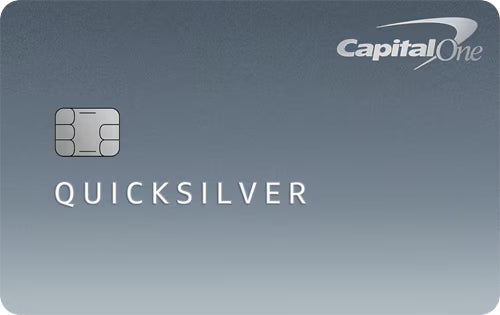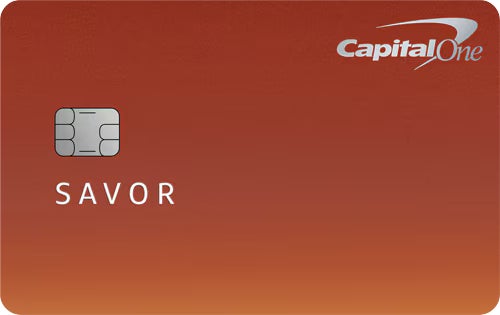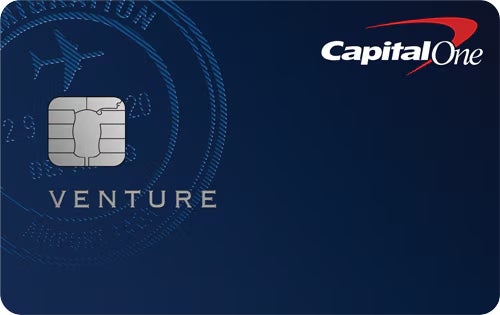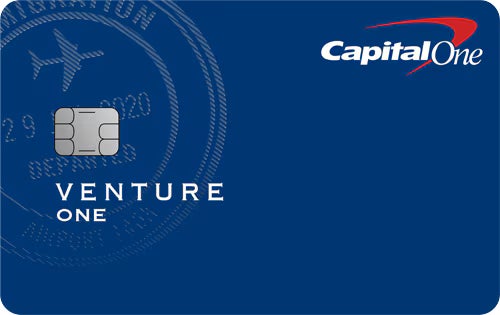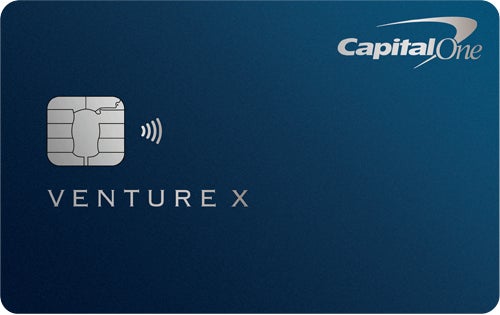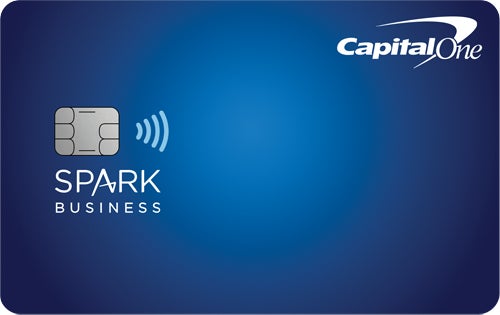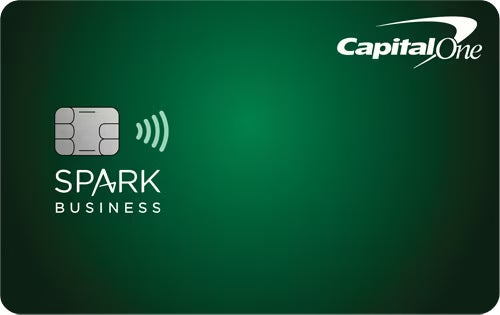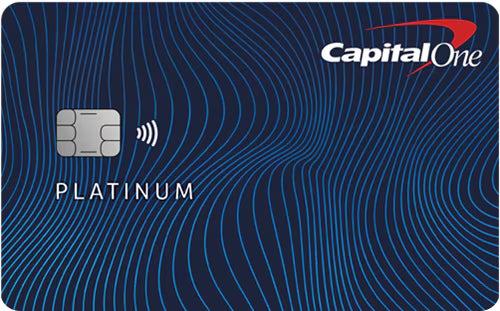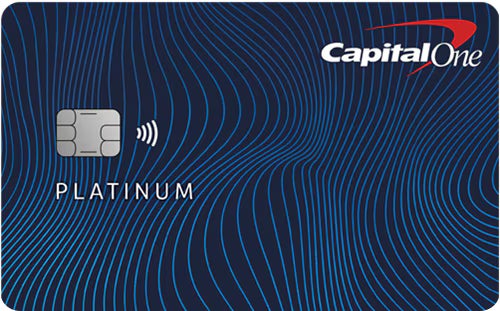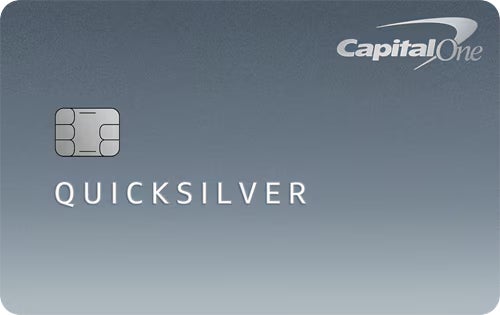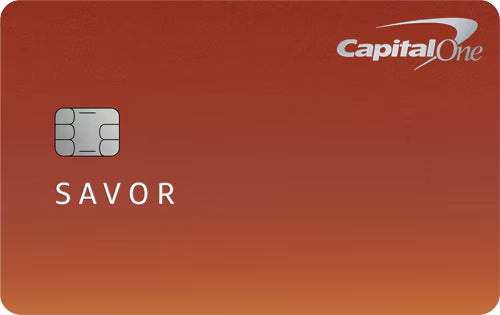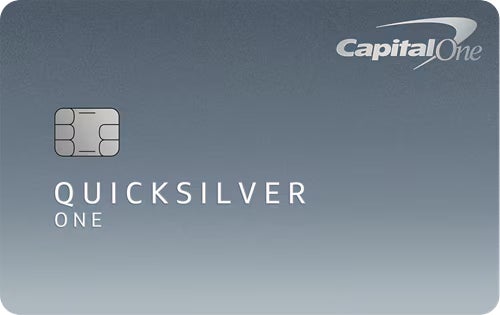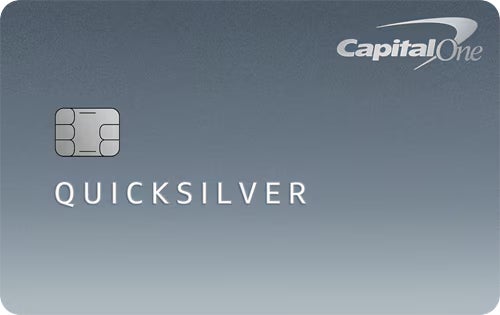*All information about the Walmart Rewards® Mastercard®, The One Card, Journey Student Rewards from Capital One, Citi Custom Cash Card, and the Bank of America® Customized Cash Rewards credit card has been collected independently by CreditCards.com and has not been reviewed by the issuer.
For Capital One products listed on this page, some of the benefits may be provided by Visa® or Mastercard® and may vary by product. See the respective Guide to Benefits for details, as terms and exclusions apply.
*The Journey Student Rewards from Capital One is no longer available.
Comparing the best Capital One credit cards
Capital One’s exciting lineup includes business, cash back and travel rewards credit cards, as well as vehicles for credit building. Here is a comparison of the best Capital One credit cards of 2025:
Editor’s picks: A closer look at our top-rated Capital One credit cards
Best for cash back: Capital One Quicksilver Cash Rewards Credit Card
- Best features: Unlike the QuicksilverOne, which accepts people with lower credit, the Quicksilver has no annual fee (See rates and Fees). This card is a prime choice when you’re looking for a no-annual-fee credit card that has across-the-board boosted ongoing rewards.
- Biggest drawbacks: If you are willing to pay an annual fee, you can get a better welcome offer and better tiered ongoing rewards, as with the Blue Cash Preferred® Card from American Express ($0 intro annual fee, then $95). Learn more about the best cash back credit cards.
- Alternatives: The Citi Double Cash® Card offers a higher cash back rate than the Quicksilver card. You can earn up to 2 percent cash back on all your purchases: 1 percent cash back when you make a purchase and another 1 percent back when you pay for those purchases.
- Bottom line: The Capital One Quicksilver Cash Rewards Credit Card is great for people who want the freedom of cash back without having to worry about rotating categories. It offers unlimited 1.5% back on all purchases. Plus, there’s a sign-up bonus that lets new cardholders earn $200 after spending $500 in their first three months.
Read our Capital One Quicksilver Cash Rewards Credit Card review.
Best for dining rewards: Capital One Savor Cash Rewards Credit Card
- Best features: There’s a $200 cash bonus after a total $500 spend within the first three months. In addition to the great dining rewards, you get 5% cash back on hotels and rental cars booked through Capital One Travel, 3% cash back on popular streaming services and at grocery stores (excluding superstores like Walmart® and Target®) and 1% cash back on all other purchases. Plus, earn 8% cash back on Capital One Entertainment purchases.
- Biggest drawbacks: Although there’s no annual fee (See rates and Fees), this card’s sign-up bonus is in the middle of the pack when compared to other cash back cards.
- Alternatives: A popular choose-your-bonus-category rewards card, the Bank of America® Customized Cash Rewards credit card* offers 3% cash back in a category of your choice (including gas, online shopping, dining, travel, drugstores or home improvements and furnishings) and 2% cash back on grocery store and wholesale club purchases (on up to $2,500 in combined purchases each quarter on 2% and 3% categories).
- Bottom line: It’s practically unheard of to find a no-annual-fee cash back card that offers 3% cash back on dining and entertainment with an unlimited spend. If you’re a foodie, the Savor is a great option.
Read our Capital One Savor Cash Rewards Credit Card review.
Best for travel rewards: Capital One Venture Rewards Credit Card
- Best features: The Venture Rewards’ 2X miles on purchases are solid, as is the sign-up bonus where you earn 75,000 bonus miles once you spend $4,000 on purchases within the first three months, plus receive a one-time $250 Capital One Travel credit in your first cardholder year, that’s equal to $1,000 in travel. Additionally, earn 5X miles on hotels, vacation rentals and car rentals booked through Capital One Travel. As with all Capital One credit cards, there are no foreign transaction fees (See rates and Fees).
- Biggest drawbacks: While the Venture Rewards card now has airline partners, the transfer ratio is less than that of some other competitor travel cards.
- Alternatives: One of the Venture card’s biggest competitors, the Chase Sapphire Preferred® Card offers a sign-up bonus of 100,000 points after spending $5,000 in the first three months, worth $1,250 when redeemed for travel through Chase Travel℠.
- Bottom line: If you are looking for rewards and don’t want to be tied down by a specific travel brand, the Venture Rewards is perfect. As one of the best credit cards for travel rewards, it’s worth your while if you do a fair amount of traveling, even with a $95 annual fee (See rates and Fees).
Read our Capital One Venture Rewards Credit Card review.
Best for no annual fee: Capital One VentureOne Rewards Credit Card
- Best features: The VentureOne is an option if you’re looking for a travel card with flexibility in redemptions and partnerships with a handful of airlines. Cardholders can earn 20,000 miles if they spend $500 within the first three months of account opening (See rates and Fees).
- Biggest drawbacks: The ongoing rewards of 1.25X miles on purchases could be better, depending on your spending habits. In fact, the Capital One Venture Rewards offers higher base rewards (2X miles on purchases) in exchange for a $95 annual fee (See rates and Fees). Learn how to determine whether the Venture Rewards or the VentureOne Rewards is right for you.
- Alternatives: Compared to the VentureOne, the Capital One Venture card comes with a higher earning rate, sign-up bonus and more travel perks, but you’ll have to pay a $95 annual fee (See rates and Fees).
- Bottom line: The VentureOne is a solid first travel card with no annual fee (See rates and Fees) as well as no foreign transaction fees and a decent sign-up bonus.
Read our Capital One VentureOne Rewards Credit Card review.
Best for unlimited miles on purchases: Capital One Venture X Rewards Credit Card
- Best features: The first-year savings are impressive thanks to the sign-up bonus. Earn 75,000 bonus miles when you spend $4,000 on purchases in the first three months from account opening.
- Biggest drawbacks: There’s a $395 annual fee (See rates and Fees), and the $4,000 spend requirement to earn the bonus miles may not be an easy ask for all travelers.
- Alternatives: Another standout in the luxury travel space, The Platinum Card® from American Express is famous for its generous roster of cardholder perks, which could translate to thousands of dollars’ worth of value if you take full advantage.
- Bottom line: This premium card in the Venture rewards lineup is for the frequent traveler ready to make the most of their travel rewards credit card. The Capital One Venture X Rewards card comes with a large sign-up bonus, unlimited miles in all purchase categories (with no expiration or blackout dates), lounge access and a statement credit worth up to $120 for Global Entry or TSA PreCheck. Cardmembers also get 10,000 bonus miles (worth $100 toward travel) every year on your account anniversary, and there is an annual credit worth $300 when you book travel through Capital One Travel.
Read our Capital One Venture X Rewards Credit Card review.
Best for business travel: Capital One Spark Miles for Business
- Best features: The Spark Miles card’s $95 annual fee (See rates and Fees) is waived the first year, and the ongoing rewards are the same, making it a good card to have for travel.
- Biggest drawbacks: The Spark Miles earns you 50,000 miles after a $4,500 spend within the first three months of card membership, making the required spend a potentially high barrier.
- Alternatives: Rather than a flat rate of rewards, the Chase Ink Business Preferred® card offers 3 points per dollar in several bonus categories: travel, shipping, internet, cable, phone services and advertising purchases (up to $150,000 in combined purchases yearly).
- Bottom line: The Spark Miles for Business is similar to the Spark Cash Plus, except you get miles instead of cash back, making it a good choice for frequent business travelers.
Read our Capital One Spark Miles for Business review.
Best business card for flat-rate cash back: Capital One Spark Cash Plus
- Best features: You’ll earn unlimited 2% cash back on all qualifying purchases, with no need to track spending or enroll in bonus categories. There’s a one-time cash bonus where you can earn $2,000 once you spend $30,000 in the first three months and earn an additional $2,000 cash bonus for every $500,000 spent during the first year. Plus, this card comes with some business-friendly benefits including free employee cards (See rates and Fees), itemized year-end summaries, as well as virtual card numbers.
- Biggest drawbacks: As a charge card, this card requires you to pay off your balance in full each billing cycle. It carries no ongoing APR or 0% introductory APR offers (See rates and Fees), making it less useful if you need to free up cash flow or chip away at business expenses over time. Also, it carries a $150 annual fee (See rates and Fees).
- Alternatives: Boasting a more attainable sign-up bonus than the Spark Cash Plus card, the Ink Business Preferred® Credit Card also carries a lower annual fee and greater redemption flexibility. You can trade your Ultimate Rewards points for cash back at 1 cent per point, or redeem for travel through Chase and enjoy a 25% boost in point value.
- Bottom line: The Spark Cash Plus card offers excellent value in spite of its annual fee, including a lucrative sign-up bonus, one of the best flat cash back rates you can find on a business rewards card and a great annual fee refund for big spenders.
Read our Capital One Spark Cash Plus review.
Best for building credit: Capital One Platinum Credit Card
- Best features: This card accepts people with average, fair or limited credit. There is no annual fee (See rates and Fees), unlike the QuicksilverOne, but like the QuicksilverOne, you may be considered to increase your credit limit after the first six months of on-time payments and responsible use.
- Biggest drawbacks: There are no ongoing rewards with this card, unlike the QuicksilverOne.
- Alternatives: Another unsecured option from Capital One, the QuicksilverOne Cash Rewards Credit Card offers simple rewards and some limited but noteworthy benefits while also only requiring fair credit to qualify – notably a flat 1.5% cash back rate on all eligible purchases.
- Bottom line: Need a leg up on your credit? Look no further. The Platinum is a great first card or a solid option if you’re trying to build credit with responsible card use.
Read our Capital One Platinum Credit Card review.
Best for secured credit card: Capital One Platinum Secured Credit Card
- Best features: Secured credit cards require a security deposit, but the barrier for entry with this Capital One card is quite low: $49 to $200. Higher security deposits may qualify for up to a $1,000 credit limit. Cardholders can be considered for higher credit lines by making their first six monthly payments on time and with responsible use.
- Biggest drawbacks: As we mentioned, you are required to put down a refundable deposit that you will be borrowing off of for your credit limit. Plus, if you do carry a balance, the annual percentage rate is rather high. There is no sign-up bonus or ongoing rewards.
- Alternatives: Another offer from Capital One, the Quicksilver Secured Cash Rewards Credit Card, has a higher security deposit requirement but also comes with a 1.5% flat-rate cash back rewards benefit on all eligible purchases.
- Bottom line: This secured credit card is designed to help people with thin to no credit establish a payment history. Given the Capital One Platinum Secured Credit Card accepts people with bad or limited credit, it’s also an option for people looking to repair their credit scores.
Read our Capital One Platinum Secured Credit Card review.
Best student card for flat-rate cash back: Capital One Quicksilver Student Cash Rewards Credit Card
- Best features: This card makes it simple to earn and redeem rewards. Plus, students will enjoy a number of consumer-friendly benefits, including no annual fee and no foreign transaction fees (See rates and Fees).
- Biggest drawbacks: Some students might not be prepared for a rewards credit card. If spending to earn rewards causes any concern, consider a more basic student credit card that offers credit-building incentives.
- Alternatives: The Discover it® Student Cash Back offers student-friendly benefits and a high cash back rate in rotating bonus categories, though it requires some effort on your part to maximize those.
- Bottom line: The student version of this popular cash back credit card from Capital One offers a best-in-class 1.5% cash back on all purchases and provides simple, yet generous redemption options.
Read our Capital One Quicksilver Student Cash Rewards Credit Card review.
Best for entertainment seekers: Capital One Savor Student Cash Rewards Credit Card
- Best features: The bonus categories this card offers will click with some students’ existing spending habits, and the rate of cash back is extremely generous for cards in this class. In addition, students won’t have to worry about an annual fee or foreign transaction fees (See rates and Fees).
- Biggest drawbacks: If you don’t spend money on the card’s student-focused bonus categories, you’ll probably see more value from a flat-rate student rewards credit card. Undisciplined spenders might also find the ability to earn ample rewards distracting while trying to build credit, particularly since the bonus categories largely focus on discretionary spending categories.
- Alternatives: Though the Savor Student card offers several lucrative cash back categories, it’s hard to match the level of variety you’ll get with the Discover it® Student Cash Back card’s rotating bonus categories.
- Bottom line: Students can rack up rewards in categories they may already be spending on, such as dining, entertainment and streaming services. Plus, this card offers a best-in-class return on non-rotating bonus categories among student credit cards.
Read our Capital One Savor Student Cash Rewards Credit Card review.
Best for limited credit history: Capital One QuicksilverOne Cash Rewards Credit Card
- Best features: This card has the same ongoing rewards as the Quicksilver Cash Rewards, making it a compelling choice for your wallet.
- Biggest drawbacks: The QuicksilverOne doesn’t have the sign-up bonus of the Quicksilver, and it carries an annual fee of $39 (See rates and Fees), which isn’t waived the first year.
- Alternatives: If your main focus is building your credit through responsible use, the Capital One Platinum Credit Card is a great option with no annual fee (See rates and Fees).
- Bottom line: We love this card’s generous rewards rate which really stands out from other credit-building cards and makes it easy to recoup its annual fee.
Read our Capital One QuicksilverOne Cash Rewards Credit Card review.
Best secured card for flat-rate rewards: Capital One Quicksilver Secured Cash Rewards Credit Card
- Best features: Like many Capital One credit cards, this latest addition to its line-up features a number of consumer-friendly terms, including no annual fee and no foreign transaction fees (See rates and Fees).
- Biggest drawbacks: Some secured cards have lower minimum security deposit requirements. The card’s APR is high, so you’ll want to refrain from carrying a balance on this card. That’s a best practice in general, but it’s particularly important with secured credit cards, which tend to have low credit limits.
- Alternatives: If you’d rather not put up the large deposit required by the Quicksilver Secured Cash Rewards, with the Capital One Platinum Secured card you can put down as little as $49 and still get a starting credit limit of $200, all while paying no annual fee (See rates and Fees).
- Bottom line: This new Capital One credit card touts one of the most generous rewards programs attached to a secured credit card: unlimited 1.5% cash back on all purchases.
Read our Capital One Quicksilver Secured Cash Rewards Credit Card review.
Best for students: Journey Student Rewards from Capital One*
- Best features: For those just dipping their toe into the world of credit, this is a great card for learning healthy financial habits and earning rewards with responsible use. Plus, students who study abroad will love the fact that there are no foreign transaction fees.
- Biggest drawbacks: One possible disadvantage for young cardholders is the high APR. If you think you may not be able to pay the balance in full each month, you’ll keep more money in your pocket by pursuing a card with a low interest rate.
- Alternatives: For students planning to carry a balance from time to time, the Discover it® Student Cash Back offers an intro APR on purchases.
- Bottom line: The *Journey Student Rewards card incentivizes healthy credit habits with built-in features like a 25% boost to your rewards earnings for paying your bill on time each month. Instead of 1% cash back on general purchases, you’ll get 1.25%. Also, cardholders are automatically considered for a credit line increase after six months of on-time payments.
Read our Journey Student Rewards from Capital One review.
Best for online shopping: Capital One Walmart Rewards Mastercard*
- Best features: It’s 5% rewards rate for online Walmart orders and 2% rate at Murphy USA and Walmart® fuel stations. Plus, it has a digital-first approach. Cardholders get instant access to their card with the Walmart Pay app, making it a reliable tool for families and budget shoppers alike.
- Biggest drawbacks: It doesn’t offer any intro APR purchases, which knocks it down a couple pegs compared to other grocery and gas credit cards.
- Alternatives: The Citi Custom Cash® Card* can offer the same rewards rate as the Walmart Mastercard for grocery or gas purchases, plus it has an intro APR period on purchases and balance transfers.
- Bottom line: The Walmart Mastercard is a great fit for people who shop frequently at the big-box store, offering impressive rewards rates for household purchase categories. However, it lacks some benefits that could make it more competitive.
Read our Capital One Walmart Rewards Mastercard review.
What is Capital One?
Capital One, formally known as Capital One Financial Corp., is the fifth-largest consumer bank and the eighth-largest bank overall in the U.S. Founded by now Chairman and Chief Executive Officer Richard Fairbank, it reported a total net revenue of $28.5 billion in 2020. Per the Nilson Report, Capital One held a 10% market share of purchase volume among credit card issuers as of 2020.
Services offered by Capital One
Capital One currently offers a wide breadth of consumer and commercial financial services. These services include:
Consumer
- Credit cards – from credit building to rewards and cash back
- Banking – from checking and kids’ savings to CDs and IRAs
- Auto – for new or used car loans, or refinancing
- Invest – through Capital One Investing
Business
- Credit cards – Spark Cash and Spark Miles
- Banking – checking and savings
- Borrow – includes business loans
- Invest – includes creating 401(k) plans
- Manage – merchant services and cash management
Commerical
- Commercial lending – from term loans to lines of credit
- Depository services – commercial checking, savings or CDs
- Treasury management – digital tools and automated solutions
- Capital markets – from foreign exchange to public finance
- Private banking & wealth management – from asset management to trust services
- Corporate card – The One Card from Capital One simplifies expenses, accounts payable and billing processes
Is a Capital One credit card worth it?
As one of the largest banks in the U.S., Capital One is able to offer a commendable collection of cards that can exceed any annual costs. There are some circumstances where cardholders pick the wrong card and find themselves in an uphill climb, but those who do their homework beforehand should end up with a valuable card. With the Savor Cash Rewards, the Venture Rewards, the Platinum Card and many more, Capital One gives cardholders chances at strong rewards, generous welcome bonuses, credit-building opportunities and useful benefits. Also, with the Capital One rewards program and Capital One travel rewards program, cardholders have access to easy and flexible redemption options to make their spending worthwhile.
Some of Capital One’s extra perks and add-ons are geared to help travelers more than anyone else, but they’re not exclusive to one group. From no foreign transaction fees to travel accident insurance, Capital One cards offer a plethora of benefits, including travel and retail; apps and digital services; and security. Here’s what this bank issuer offers:
Travel and shopping
- No foreign transaction fees: Capital One cards don’t charge foreign transaction fees, saving you about 3% to 5% per purchase outside the U.S. As such, its cards are among the best credit cards for no foreign transaction fees.
- 24-hour travel assistance: You can get an emergency replacement card and a cash advance any time, along with emergency, medical, travel and legal referral services. The extent of services available (like roadside assistance) varies by card.
- Auto rental collision damage waiver: An eligible rental vehicle is covered for damage due to theft, collision or possibly towing charges. Further coverage may depend on your card and whether it’s a domestic or international rental.
- Travel accident insurance: When the entire travel fare is purchased using your card, eligible losses are covered at no extra charge.
- Extended warranty: At no extra charge, you could receive an extended warranty on eligible items purchased with your card.
- Mile transfer: Venture and VentureOne miles can be transferred to any of Capital One’s 15+ travel loyalty programs for the adaptability your trip needs.
- Experience Access: Foodies, travelers and sports fans get access to cardholder-exclusive premium experiences, including dining, music, sports and entertainment events.
- Capital One Shopping: This browser extension from Capital One saves online shoppers money by scanning the web for lower prices on your item.
Security Services
- Security and account alerts: Capital One monitors your account and can notify you through text, email and phone if they notice possible suspicious transactions.
- Fraud coverage: In case your credit card was stolen, Capital One’s $0 fraud liability means you won’t even have to pay the Federal Trade Commission’s $50 liability limit for verified unauthorized purchases.
How to choose a Capital One credit card
The best Capital One credit card for you will vary, based on your spending habits, credit profile and financial goals. Using our CardMatch tool, you can align your financial profile with cards in your range to narrow down your options easier before applying. Here are some typical shoppers that can specifically benefit from certain Capital One products:
Who should get a Capital One credit card
- The foodie who loves dining out. The Savor Cash Rewards card’s 3% cash back on dining out and entertainment (and no annual fee – See rates and Fees) is a strong choice for restaurant lovers and people eager to get back out after too much time inside. And for shoppers who want the rewards but a less-specialized structure, the Quicksilver and QuicksilverOne cards have the same across-the-board cash back offer.
- The traveler. There are two options for the traveler, both great for domestic and international, and they are the Venture Rewards and the VentureOne Rewards. The VentureOne is best for the occasional traveler who just can’t justify an annual fee (See rates and Fees), and the Venture is great for the traveler who wants to max out spending. You can learn how to take full advantage of Venture Rewards and as with any of Capital One’s options, you’ll be free from foreign transaction fees.
- The seeker of convenience. Want a cash back card that you don’t have to think much about in order to get great rewards? The Quicksilver and QuicksilverOne cards have the same across-the-board cash back offer, although the QuicksilverOne has an annual fee and no sign-up bonus in exchange for only recommending fair credit.
- The consumer just starting out. If you have thin or fair credit, Capital One offers multiple cards to choose from. The Capital One Platinum (See rates and Fees) is a good choice for the consumer with fair credit, while the Capital One Quicksilver Secured (See rates and Fees) accepts consumers who have no credit history. Also, the *Journey Student Rewards card is a great starter option, and all come without an annual fee.
- The business owner. Whether you travel often for work or you have a fair amount of business expenses, Capital One has two business cards to choose from – the Capital One Spark Cash Select offers cash back on all eligible purchases, and the Spark Miles for Business offers miles on all eligible purchases. The Spark Miles has a $95 annual fee that is waived the first year (See rates and Fees) and the Spark Cash Select has no annual fee (See rates and Fees).
Who should skip a Capital One credit card
- The road warrior. If you spend a ton of time behind the wheel and know that filling up on gas is far and away your biggest expense, you should get rewarded for it. Although Capital One can get you consistent cash back across all purchases, gas cards can provide better rates at the pump.
- The cash back strategist. Some experienced credit card users love the idea of rotating cash back categories, but you won’t find that opportunity with Capital One. With one of these cards, your high-earning rewards category will change from quarter-to-quarter, giving the opportunity for savvy cardholders to capitalize on top-notch rewards with the right timing.
- The debt solver. Consumers looking to pay down outstanding credit card balances by transferring to a card with a low- or no-interest introductory period should look to top balance transfer cards. Capital One doesn’t specialize in balance transfer offers, and their ongoing APR rates mean you could pay high interest expenses if you carry a balance.
- The luxury traveler. While Capital One has great travel options, someone looking for access to airport lounges, free checked bags and other high-end perks will have to look to premium travel cards for their ticket in.
What credit score is needed for a Capital One credit card?
Capital One has options for nearly anyone, so there’s no minimum requirement to become a cardholder. That being said, Capital One’s top card options that feature lucrative rewards and strong sign-up incentives usually require a good-to-excellent score (670 or above) to be approved. If you’re unsure if your score is enough for one of their cards, you can check if you’re preapproved with Capital One.
With their secured cards and student options, people with poor credit scores or no credit history have a chance to benefit from Capital One’s services. The Quicksilver Student Cash Rewards (See rates and Fees), the Quicksilver Secured Cash Rewards (See rates and Fees) and the *Journey Student Rewards are just a few of their options for someone with a fair credit score or no credit history. Plus, these cards can earn a little cash back and keep you away from an annual fee while you improve your credit score.
What programs does Capital One offer?
On top of the plethora of benefits provided, cardholders will want to familiarize themselves with the Capital One rewards program and Capital One Travel. Known for being user-friendly and flexible, the rewards program makes it easy for cardholders to evaluate their rewards and decide what to do with their miles.
Carriers of the Venture Rewards, Spark Miles for Business and other Capital One cards offering ways to earn miles have lots of reasons to love the Capital One rewards program and Capital One Travel. For starters, miles are unlimited in the program and you have the option to transfer to any of Capital One’s numerous transfer partners, expanding your map of travel destinations for 2022. If you decide to redeem your miles for travel, you’ll use the Capital One Travel portal, where you can earn extra miles per dollar when transferring to certain partners and booking things like flights, hotels and rental cars. Plus, rewards won’t expire and there are no setbacks in terms of blackout dates, transfer fees or losing point value.
In addition to redeeming for travel, you can use the Capital One rewards program to exchange your miles for statement credits, gift cards and Amazon purchases at the average value of 1 cent per mile. Like most rewards credit cards, the travel opportunities are typically the most worthwhile options, but Capital One provides flexibility in case you want to take a different route.
Maximizing what these programs have to offer will be different depending on the cardholder, but to put it briefly: make sufficient payments, hit your sign-up bonus spend requirement, pay attention to your spending categories, look for boosted rewards opportunities and remember to redeem your miles.
How to make the most of a Capital One credit card
- Align your spending with your card. Before applying for one of Capital One’s rewards cards, review where you spend the most money. Be sure that you apply for a card that will be worthwhile, so you can get the most out of your card’s cash back categories or travel miles. If you pay attention to where you spend with your card, Capital One’s options can lead to huge savings.
- Use their travel benefits. Spark Miles and Venture cardholders should take advantage of the value bonus their miles get when transferring with select carriers to maximize their earnings. Also, Capital One’s long list of travel partners give cardholders the chance to explore places otherwise unreachable. Cardholders will also appreciate the lack of foreign transaction fees when traveling abroad.
- Earn the sign-up bonus. As a general rule with credit cards, you shouldn’t apply for a card with an unattainable sign-up bonus. If you’re approved for a Capital One credit card, be sure that the necessary spending early on is within reach. Also, some options here have bonuses in place at both three months and six months, allowing for some extra earning. Sign-up bonuses are an easy way for cardholders to squeeze immediate value out of their cards.
- Track your spending. By being attentive to how much –and where– you spend, you not only set yourself up for success in earning the most out of your purchases, you’ll be in a great spot to make sufficient regular payments. This is especially crucial with Capital One cards, which often carry high interest rates.
How we picked the best Capital One credit cards
We analyzed Capital One’s credit cards to identify the top products in popular credit card categories. The criteria considered in our analysis include:
- Rewards program: We considered whether a card’s base rewards program was competitive for its category (travel, dining, cash back, etc.) to assess long-term value. We also factored in any sign-up bonuses that might sweeten offers in the short-term.
- Special features: For credit cards for fair credit, we considered whether there were unique features, such as the ability to increase your credit limit after a series of on-time payments, that could prove helpful to someone who is trying to establish or repair their credit history. For rewards credit cards, we considered whether there were ancillary benefits, like extended warranties or travel assistance, that might add more value.
- Rates and fees: We considered whether an annual fee was justified by a card’s rewards program, unique features or less stringent credit requirements. We also factored in whether the card’s purchase, balance transfer and/or penalty annual percentage rates were competitive for its card category.
Many of Capital One’s cards are well-suited to a general audience, so, ultimately, the right card for you will hinge on what you’re looking to use it for. If you’re still torn between a few offers, check out this guide to choosing a credit card.
Additional information on Capital One credit cards
For more information on all things Capital One credit cards, continue reading content from our credit card experts:
About the Author

Adriana Ocañas
About the Editor

Tracy Stewart
Tracy Stewart is a personal finance writer specializing in credit card loyalty programs, travel benefits, and consumer protections. He previously covered travel rewards credit cards, budget travel, and aviation news at SmarterTravel Media. His money-saving tips have appeared in the Washington Post, the Wall Street Journal, Consumer Reports, MarketWatch, Vice, People, the Zoe Report and elsewhere.
About the Reviewer

Sally Herigstad
Sally Herigstad is a certified public accountant, author and speaker who writes about personal finance for CreditCards.com. She also writes regularly for MSN Money, Interest.com, Bankrate and RedPlum.com, and has been a guest on Martha Stewart radio and other programs.

